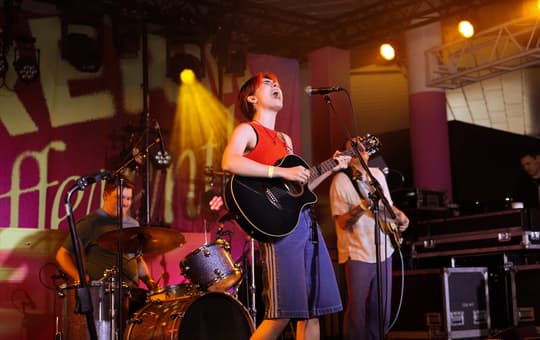Essay: Sci-Fi, Hi-Tech, Future?
Recently I went to a fancy dress party with a sci-fi theme. It turned out to be quite a devious theme to dress for – all too easy be lazy, to look awkward, to yield too much of the inner nerd – but the hosts said it was chosen because sci-fi was going to be big this summer. It’s true that sci-fi is very popular nowadays, and well outside its usual fan base too. Since Avatar, Star Trek, and the sleeper hits Moon and District 9, Hollywood and its audience have been best friends with deep-future, dark, hi-tech sci-fi, with Oblivion, After Earth, the upcoming Elysium and a blockbusting Star Trek sequel this year. Ten years ago, watching Star Trek or Doctor Who (also back) on a Saturday night was the secret shame of the fanatic – now it’s practically universal entertainment.
Sci-fi, hi-tech and hi-def certainly provide a welcome alternative to the yellowing, musty retro that’s been all over culture in the past decade, and this change is being felt significantly in the new music underground. But does it actually have anything to do with looking towards the future itself? I once disparagingly referred to the vogue for retro in underground music as “dressing up as the past”, but is it possible to “dress up as the future”? There were some answers at the party, which served as a reminder that what feels like the future and its possibilities is often little more than a collection of familiar reference points, and quite old ones at that. The walls of the house were decorated with photographs of galaxies and the surface of Mars, the classic films Silent Running (1972), 2001: A Space Odyssey (1968) and Barbarella (1968) were beamed onto a wall. What colour is the future? Mostly silver (the colour I’d painted my nails was worn by almost everyone else), with a little bright green, blue and red. Who lives there? Astronauts, robots and aliens. Science fiction has been this way since the Second World War at least, and it has heavily informed – monopolised, even – our ideas about what is futuristic, about “futureness.” This is not to say that celebrating such futuristic themes isn’t fun and thought-provoking, even if they are put together with historical materials. But where does sci-fi end and the future begin?
Music has its own equivalents of sci-fi, both in connection with the literature and in its own sonic tools. Perhaps the strongest sci-fi-esque element for music is the use of cutting edge technology, which most often has meant the synthesiser. In the late 1950s and early 1960s explicitly sci-fi themed space age lounge and exotica music by the likes of Esquivel and Bobby Christian was marketed to the increasing hi-fi-owning public, employing early synthesisers and electric instruments like the Theremin. In 1962, the Joe Meek-produced Telstar, performed on an early synthesiser by The Tornados, got to number one in the UK, the US, Belgium, Ireland and South Africa – it was an ode to a new satellite. The most powerful association between hi-tech music and sci-fi was formed in the cinema, however, with scores for films like Forbidden Planet, The Day the Earth Stood Still, The Andromeda Strain and Stalker. Vangelis’s famous score for robot film Blade Runner was a part of this tradition, its soundworld explored more recently by Kuedo on ‘Severant’. Over the years, an association between synthesisers and sci-fi concepts such as robots and aliens was firmly ingrained.
The Tornados – Telstar
It was Kraftwerk who brought the association of hi-tech music with robots into pop music, and alongside them, acts like Tangerine Dream brought in the association of hi-tech music with the cosmos. These associations have in turn given rise to an association between the future and a certain way of writing synthesiser music: basic, stilted, metronomic and repetitive like robots were seen to be – not just more than human but also a lot less than human. This association that persists to this day, even as artists such as Boards of Canada, Stereolab, Broadcast and Daft Punk frame it as historicised, problematic or kitschy. Only a little further along, the shadow of hi-tech dance genres like techno and jungle, which added speed to the aesthetic criteria, still informs many people’s ideas about what constitutes proper future and progressive music. The idea formed that future music can’t just simply be new – in order to be future it has to be hi-tech and fast in particular ways, much like a sci-fi party will celebrate particular tropes such as robots and aliens that look and sound a particular way.
“With the decline of retro and lo-fi within the tastes of the new music underground comes the rise of hi-tech and of interest in the future.”
This late-twentieth-century Kraftwerkian paradigm of future music is beginning to disintegrate and mutate. But with the decline of retro and lo-fi (the two have been practically synonymous) within the tastes of the new music underground comes the rise of hi-tech and of interest in the future. Very often this stuff is fresh and exciting, though it’s not always as free from the clutches of the past as it might appear to be. In any case, the term “future”, notably used as an adjective, is appearing more and more, and some blogs and magazines are orienting themselves towards it, even if sometimes with a faint air of “dressing up”. Compare, for example, the name and design of an old and very eminent mp3 blog founded in 2005 with a more recent one and its by-line. Indeed, there’s been a turn towards hi-tech music motivated by some of the biggest artists of recent years: Laurel Halo, Oneohtrix Point Never (especially as part of Ford & Lopatin), Gatekeeper, Fatima Al Qadiri, James Ferraro, Autre Ne Veut, even Zola Jesus and Grimes to some extent, many others, and now The-Drum particularly. These artists use synthesisers, but they’ve largely moved beyond the sound palette often called “electro” – the more basic synth sounds of the 1970s and early 80s – and into more complex technologies such as FM and sample-based synthesis, the sort that rose to prominence in the mid 80s, used by artists such as Depeche Mode, The Art of Noise and many of the acts associated with the New Jack Swing style.
The clearest embodiment of these hi-tech sounds as a pastiche of that time is Daniel “Oneohtrix” Lopatin and Joel Ford’s project Ford & Lopatin, on their album ‘Channel Pressure’. A cousin to the chillwave-hypnagogic- vaporwave stylistic family, the album evokes studio engineers in 1982 who spend their days making hi-tech adult contemporary lounge pop surrounded by the latest equipment and their nights riding in Lamborghinis wearing satin suits and big sunglasses. Or maybe they really spend most of their time writing demos to show off the new equipment at trade fairs. The tracks Channel Pressure, Emergency Room and Too Much MIDI (Please Forgive Me) embody this historicised aesthetic of hi-tech particularly – the latter even features the lyric “no more lo-fi”. It’s also part of the design and atmosphere of Ford & Lopatin’s label Software, where Napolian especially (on ‘Rejoice’) explores a similar feel.
Other hi-tech artists have a slightly more contemporary, slightly less straightforwardly retro sound. Zola Jesus’s album ‘Conatus’ brought in intricate circuit-board sounds (on Vessel and Shivers particularly) that complicated her prior characterisation as a neo-80s goth. Grimes’s album ‘Visions’ was pretty cybernetic in places like Eight and Circumambient. The Hippos in Tanks label, James Ferraro and many of the artists surrounding dis magazine have been heavily hi-tech in the past couple of years, using it as a quasi-satirical revelation of contemporary culture (most recently Yen Tech on his ‘Revengeance’ mixtape). The most “futuristic” dance forms of the late twentieth century fit neatly into this milieu – every now and then you run into a bit of jungle (as on Physical Therapy’s ‘Safety Net’) or some acid house timbres (as on Gatekeeper’s ‘Exo’), while seapunk brought a taste for 90s hardcore into its sparkling waters. The Roland TR-808 drum machine – thirty-three years young – is still a great tool of hi-tech and its age hardly undermines a future-flavoured track – on the contrary. It appears as a hallmark of footwork and the ‘trap’ hip hop style and gave Kuedo’s otherwise retro ‘Severant’ its vital dash of the contemporary.
One home for recent hi-tech sounds has been the Dutch label Zoology. Its artists vary from dark neo-80s European dance pop instrumentals (Delaweare) to synth dream pop (Mineral Beings) to hi-fi hipster house (everglade) and to stranger creatures (4SICSX) including airy structures of crystal (Brando, Glass Eyes). My favourite is Glass Eyes, not to be confused with the much lower tech Austin, TX indie band from the 80s, Glass Eye. While broadly speaking their sound world is hi-tech in recognisable ways, there’s usually something genuinely future about their unusual combinations of textures, the inventive use of the TR-808, or the unexpected use of voice – the strange disgruntled sniff in Makes New Life on ‘Approval’ (maybe their best EP), a message in a new language wreathed in white-LED keys. Zoology’s videos match the music – check the fractalscapes of Mineral Beings’ Nightdriver and the hi-def object ontologies of Glass Eyes’ Guidance.
Glass Eyes – Guidance from Zoology Records on Vimeo.
In the same general territory as Glass Eyes is the increasingly prominent Chicago duo The-Drum, mixing hi-tech with hip hop and R&B and referencing sci-fi in the process. Their first EP ‘Heavy Liquid’ features a sample from a JG Ballard TV adaptation, their second EP ‘Sense Net’ is named after a media conglomerate in William Gibson’s seminal cyberpunk novel ‘Neuromancer’, and their debut LP ‘Contact’, out this week, shares its name with Carl Sagan’s Search for Extra Terrestrial Intelligence novel (and the 1997 film starring Jodie Foster). ‘Contact’ and ‘Sense Net’ both have radio telescopes on their covers, of the sort SETI use. ‘Sense Net’ is an extraordinarily detailed, restless journey through hi-tech and alien spaces bristling with a weird and overwhelming allure. The crazy-rich /BZE is in constant flux, its polygon corridors rotating as you move in anti-grav from module to module with a machine voice repeatedly advising you to ‘stay calm’. The gorgeous ‘/SYS’ is an alien courtly dance in shivering reverb, elegantly counter-posing slices of your human pop music.
“The music that feels most beguilingly futuristic to me doesn’t wear pre-established concepts on its sleeves, doesn’t simply dress up as something we already thought was futuristic.”
In comparison, ‘Contact’ seems a little less carefully crafted, a little less surprising, and it’s on slightly more familiar hi-tech ground timbrally, using sample-based synthesis and melodies arranged onto a sequence of different synth voices along similar lines to Art of Noise, Depeche Mode and Japan. Its restless nature no longer seems a virtue, but rather like treading water, and it feels like it could have been the score to a film adaptation of ‘Neuromancer’ from the mid-80s. This might be a nice image but it’s not much of a genuinely futuristic one – cyberpunk ought to be a constantly modern formulation rather than a chance to revisit the 80s. In this way, The-Drum are being no more genuinely futuristic than Stereolab, Boards of Canada or Broadcast are when they explore the sounds of decades earlier, embodying an idea about the future that’s been almost unchanged for decades. The teaser video gives a great impression of the album, but with its surface of cathode-ray crackle and classic rave visuals it opts for a retro, even lo-fi take on hi-tech rather than a modern one. Even so, ‘Contact’s second track Sirens is one of their best and strangest, with wooden, organic sounds, gills slurping in the swamp and inter-species warning signals. And luckily, the vinyl edition of ‘Contact’ will come with ‘Sense Net’ on its fourth side.
But although a hi-tech sound-world and a genuinely futuristic music might not always be the same thing, Glass Eyes and The-Drum, together with Zoology and the other hi-tech artists, offer some new glimpses into possible future flavours, configurations, images and emotions in those moments when they surprise, confuse or baffle the listener. The extent to which this happens will vary from listener to listener – there are no doubt listeners out there for whom even Ford & Lopatin is not just a very hi-tech experience but a futuristic experience too, one that broadens their horizons, and that’s what counts. But for many of us the experience offers little more than fond recognition and admiration of the technical accomplishment – few challenges or provocations.
For me at least, a genuinely futuristic music should go further than revisiting a series of recognisable, familiar and stable tropes, like those traditionally associated with sci-fi. These tropes do play an important role in putting us into a “future” mode of listening, readying us for an encounter with something new and establishing a faith in it, but they are not in themselves futuristic. I think something more futuristic has to be a little more abstract. The sci-fi party-goers with the best fancy dress embodied such an abstraction, covering themselves in mottled blue and silver shapes and rainbow hides in ways that could have suggested robots, aliens, and future teenage subcultures as all part of a same mysterious category that could contain many other things too, provoking the imagination without being specifically familiar. In the same way, the music that feels most beguilingly futuristic to me doesn’t wear pre-established concepts on its sleeves, doesn’t simply dress up as something we already thought was futuristic – Arca, Nguzunguzu, Lōtic, I AM WATER, Ikonika, Karmelloz, 18+, Mykki Blanco, Clams Casino. Are these artists astronauts, robots or aliens? Only in the very broadest sense – really they’re something else entirely.
Similarly, although ‘messy’ techno is quiet an abstract movement, it is not normally interpreted as ‘futuristic’ because it is a non-Kraftwerkian form of techno (anti-Kraftwerkian, even), and doesn’t have that particular Kraftwerk-derived hi-tech sound. In fact, it’s often interpreted as some kind of decay or defacement of something that was once futuristic. What if it wasn’t heard in this way, but actually as a more genuinely futuristic music – or more a modern one, at least – than traditional techno? I think it’s quite possible. It seems probable that in the future, “futureness” will move further away from the Kraftwerkian paradigm, swapping the latter’s minimalist, robotic perpendiculars for complexity, curves, something much more organic.
Two great releases that have particularly caught my ear recently for feeling so future along exactly these lines are Gita’s single Mardi Gras and Sophie’s ‘BIPP / ELLE’. Both have roots in UK grime music, but in the same way that techno and jungle were considered pretty futuristic twenty years ago, some of the weirder, gloopier strains of grime still feel pretty futuristic to me, they trigger a faith in the future and persuade me that I’m experiencing something of its possibilities. And of course, this is a progression from Wiley and Hyperdub in just the same way that Depeche Mode and techno were a progression from Kraftwerk. We can never actually reach or “be” the future 100%, we can only ever dress as its possibilities in more or less fresh and convincing ways, wearing costumes that necessarily have some familiarity and origins in the past but that hopefully were to some degree previously unimaginable to those who witness them. So hopefully there’ll be a new, different “futureness” in ten or twenty years’ time again, one that’s probably pretty unimaginable to us now – I look forward to trying it on.














